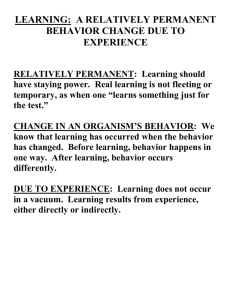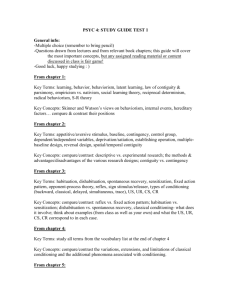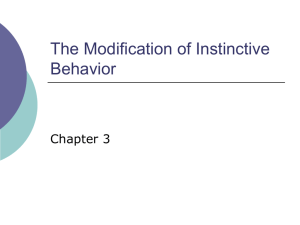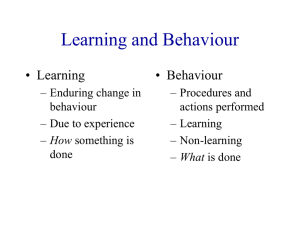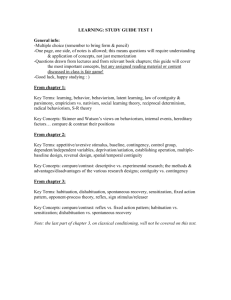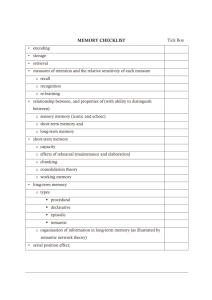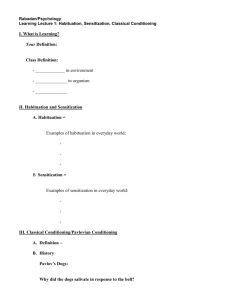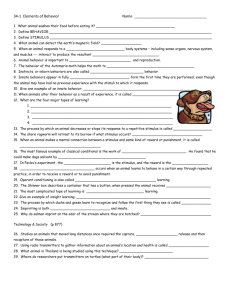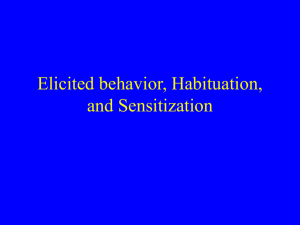lecture 2
advertisement
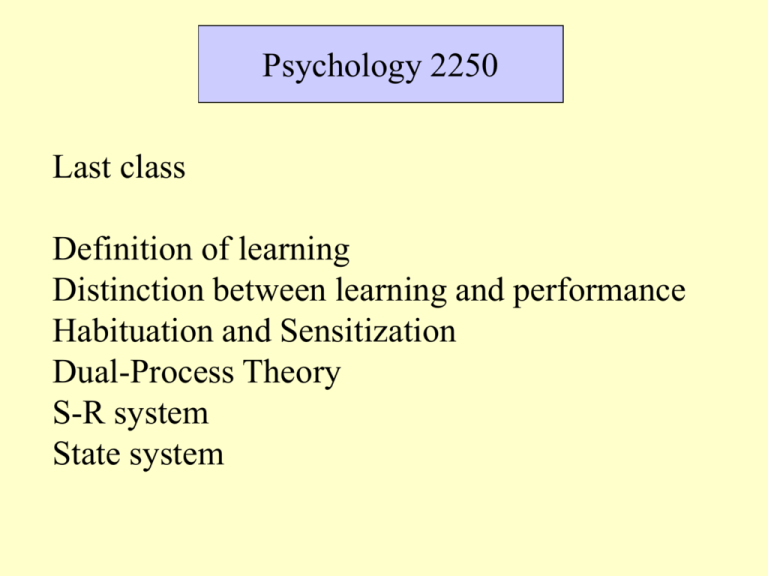
Psychology 2250 Last class Definition of learning Distinction between learning and performance Habituation and Sensitization Dual-Process Theory S-R system State system Habituation and Sensitization Characteristics of Habituation and Sensitization Time course Sensitization is usually temporary -sensitization can last for up to a week but not generally a long-term effect. -with a stronger stimulus, the effects last longer. Habituation can be short-term or long-term, depending on presentation and interval between stimuli. Short-term habituation: -rapid presentations of a stimulus with a short interval between presentations -results in habituation quickly but see spontaneous recovery -the degree of spontaneous recovery depends on length of rest interval. Long-term habituation: -one stimulus presentation a day -see more long-term effects -see less spontaneous recovery Tones Once a Day Tones Tones Every 3 seconds on 1 day Blocks of 30 Tones Leaton, 1976; see page 46 of Domjan Tones Once a Day Tones Stimulus specificity Habituation is stimulus-specific -if you change the stimulus, see recovery of the response Sensitization is not highly stimulus-specific -if an animal is aroused, it is usually aroused to a variety of cues Effects of strong extraneous stimuli If you change the nature of the eliciting stimulus you see recovery of the habituated response. Can also see recovery of the response if the animal is given a rest period = spontaneous recovery. The response can also be restored by presenting a strong stimulus— this is called dishabituation. Dishabituation refers to recovery of the response to the habituated stimulus following presentation of a different, novel stimulus. Habituation and Sensitization in Aplysia Habituation of the gill withdrawal reflex results from changes in the S-R pathway Less transmitter released here Skin SN MN Gill Dishabituation/Sensitization After the gill withdrawal reflex has habituated, a shock to the tail sensitizes the gill withdrawal reflex elicited by touching either the mantle or siphon Dishabituation is a case of Sensitization Sensitization (dishabituation) occurs because tailshock augments the release of neurotransmitter from the sensory neuron Tail Skin SN FN MN Gill The Opponent-Process Theory of Motivation (Solomon and Corbit, 1974) The concepts of habituation and sensitization have been extended to emotions and motivated behavior Common characteristics of emotional reactions 1. Emotional reactions are biphasic; a primary reaction is followed by an opposite after-reaction 2. The primary reaction becomes weaker with repeated stimulations 3. The after-reaction is strengthened The Opponent-Process Theory is a homeostatic theory The theory assumes that neurophysiological mechanisms involved in emotional behavior serve to maintain emotional stability Drug-seeking behavior a-b Observed Response Underlying Opponent Processes (a and b) a Observed So primary emotion is less affective afterreaction is greater a-b a a process: same b b Stimulus Presentation Time First Presentation of Arousing S After Many Presentations of Arousing S b process: Starts earlier Lasts longer Is larger Classical Conditioning or Pavlovian conditioning Ivan P. Pavlov was a Russian physiologist who accidentally discovered this type of learning he was studying the physiology of digestion when he noticed a funny thing. digestion starts in the mouth where saliva begins to break down food. Dogs would salivate when he put the food powder in their mouths. But experienced dogs would also salivate when the experimenter walked in the room or at the sight of food. An apparatus for Pavlovian conditioning. A tube carries saliva from the dog’s mouth to a lever that activates a recording device (far left). During conditioning, various stimuli can be paired with a dish of food placed in front of the dog. The device pictured here is more elaborate than the one Pavlov used in his early experiments. Pavlov paired the clicking of a metronome with food. Clicker Food (never used a bell) Dogs normally salivate with food but not with the clicker After a few of these pairings, dogs began to salivate when the metronome came on. The first stimulus (clicker) triggered the memory (or anticipation) of the second stimulus (food). Thus, we can say the 2 events have become associated. Association: If 2 sensations, or stimuli, repeatedly occur together, the mental reactions to those stimuli become associated such that when the first sensation or stimulus is given, it triggers the memory of the associated stimulus. Those of you with pets will have already seen this phenomenon in action. Formal definition of Pavlovian conditioning 2 stimuli occur together regardless of the subjects’ behavior in Pavlov’s original experiment, food was given even if the dogs didn’t salivate to the clicker. In this type of conditioning we set up conditions, or pairings, beforehand and present them regardless of the subject’s behavior. Decide on clicker food pairings and then present them a # of times regardless of what the animal does to the clicker. Four major terms apply to Pavlovian Conditioning experiments Stimuli US Unconditioned stimulus Biologically potent stimulus that reliably evokes an unlearned or reflexive reaction (i.e., food) CS Conditioned stimulus Biologically weak stimulus The CS may evoke an orienting response, but not the strong response evoked by the US (i.e., metronome) Responses UR Unconditioned response The unlearned response triggered by the US Powerful and reflexive (i.e., salivation to food) CR Conditioned response It is elicited by the CS and represents the learned behavior The behavioral manifestation of the underlying association between the CS and the US (i.e., salivation to the Metronome) Pavlov’s original experiment is an example of Excitatory classical conditioning. Excitatory means the CS is able to excite the CR into being. From a procedural point of view, conditioned excitation, or excitatory conditioning occurs when presentation of the CS is followed by a presentation of the US (i.e., CS US pairings). Two types of Excitatory Conditioning Appetitive CS is followed by an appetitive (good) US (i.e., food, water, mate) Aversive CS is followed by an aversive US (i.e., mild shock, illness)
